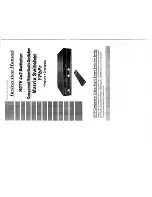
Configuring IP Information
Management and IP Interfaces
Cisco 500 Series Stackable Managed Switch Administration Guide
274
17
In Layer 3 mode on Sx500 devices only, the switch does not support MAC-
based VLAN, Dynamic VLAN Assignment, VLAN Rate Limit, SYN Rate DoS
Protection, and Advanced QoS Policers.
For Sx500 devices only, to configure the system mode (Layer 2 or Layer 3), see the
System Mode and Stack Managemen
t page
NOTE
Switching from one layer mode to another requires a mandatory reboot, and the
startup configuration of the switch will be deleted.
The following sections describe the differences between IP addressing when the
switch is in Layer 2 or Layer 3 mode.
Layer 2 IP Addressing
They are only relevant for Sx500 devices (not SG500X devices).
In Layer 2 mode, the switch has a single IP address in the management VLAN. This
IP address and the default gateway can be configured manually, or by DHCP. The
static IP address and default gateway for Layer 2 mode are configured on the
IPv4
Interface
page. In Layer 2 mode, the switch uses the default gateway, if
configured, to communicate with devices that are not in the same IP subnet with
the switch. By default, VLAN 1 is the management VLAN, but this can be modified.
When operating in Layer 2 mode, the switch can only be reached at the configured
IP address through its management VLAN.
The factory default setting of the IP address configuration is
DHCP
. This means
that the switch acts as a DHCP client, and sends out a DHCP request during boot
up.
If the switch receives a DHCP response from the DHCP server with an IP address,
it sends Address Resolution Protocol (ARP) packets to confirm that the IP address
is unique. If the ARP response shows that the IP address is in use, the switch sends
a DHCPDECLINE message to the offering DHCP server, and sends another
DHCPDISCOVER packet that restarts the process.
If the switch does not receive a DHCP response in 60 seconds, it continues to
send DHCPDISCOVER queries, and adopts the default IP address: 192.168.1.254/
24.
IP address collisions occur when the same IP address is used in the same IP
subnet by more than one device. Address collisions require administrative actions
on the DHCP server and/or the devices that collide with the switch.
















































